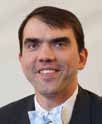Publication
Article
Pharmacy Practice in Focus: Health Systems
The Bottom Line: The Patient as Our Focus

Most people have heard the statement ”No margin, no mission.” It is frequently used in the context that an organization can never forget about the business it is in, whereby one cannot initiate activities that do not have a sustainable financial model. Are we taking this statement to extremes in the current setting of health care?
First, we need to understand what an appropriate margin is. Is it 2%, 4%, 6%, or even higher? Most hospitals are categorized as non-profit for tax purposes, but there has to be some margin in order to invest in infrastructure and capital improvements. Has health care become so focused on the margin at the expense of the patient? There are increasing salaries for health care executives and individual providers. There are increasing costs for technology and expenses associated with mergers and acquisitions. In addition, reimbursement for services rendered is less each year—and there is definitely uncertainty about the future of health care. Having cash on hand and sufficient reserves could be helpful if things get worse than they are currently.
While I am not in favor of regulating margins, excesses at the expense of the patient must be limited. Patients don’t have the option to shop around for health care services. We are all just a catastrophic event away from having extremely high medical insurance bills. While most pharmacists have a comfortable life, working hard to be productive members of society, a multimillion-dollar hospital stay could change all of that in an instant. Having a new perspective on the health care system by owing money rather than providing services gives one a completely different lens. It shows that there is tremendous waste in the current system, and how margin is sometimes preserved at the expense of the patient. I believe the best way to temper the focus on the bottom line is to truly understand your organization’s mission and pursue it. Is your primary focus the underserved in your area? Are you more focused on the insured, or a specific patient population? What are the current gaps in care? How are you doing in meeting your mission? What are the strengths of the organization?
Some hospitals are better at the acute care setting, while some excel at team-based care and others have expertise in the ambulatory care setting. Having an understanding of your core competency allows one to align the expressed mission of the organization with budgeting decisions and activities. If there is concordance, there is demonstration that the organization is pursuing its mission. If there is evidence that the organization is expanding into areas in which it does not have much demonstrated expertise, this misalignment could lead to needing excessive margins to fund these endeavors.
Unfortunately, health-system pharmacy is contributing to these excesses. Some departments are being asked to provide greater revenue or contribution margin to the organization each year. This is usually through increasing drug markups while holding down drug costs or personnel expenses. A few pharmacy departments are using the excessive margin for expansion into areas where they have previously not had a presence. This is typically in the ambulatory, mail order, or specialty pharmacy setting.
If you can state definitively that this new model is the best option for the patients you serve, then by all means pursue it. However, if you are so focused on growth and the need for revenue at the risk of allowing the patient access to the most appropriate care options, I would advise that you proceed with caution.
While I definitely understand the saying “‘No margin, no mission,” I just hope that healthsystem pharmacy does not pursue it to the extent that it becomes ”Too much margin, too few patients.”
Stephen F. Eckel, PharmD, MHA, BCPS, FASHP, FAPhA, FCCP, is associate director of pharmacy, University of North Carolina Hospitals, and clinical associate professor and director of graduate studies at the University of North Carolina Eshelman School of Pharmacy.







